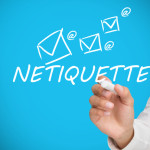Email Etiquette – 12 Ways to Keep Your Reputation Intact
June 30, 2014
Did you know that the average person spends nearly 30% of their workweek on email? According to a recent report from McKinsey Global Institute, we’re spending about 13 hours a week writing, reading, sorting, deleting and sending email. That’s a lot of time!
Email messaging now exceeds telephone use as the primary form of business communication. And that’s not surprising. Whether you’re in front of your computer or using a tablet or smartphone, it’s quick and easy to send someone an email. So simple, in fact, that many people forget that by clicking “reply,” and typing up a quick response without giving it a second thought, your message can backfire.
As with any other type of communication, missteps have the potential to sabotage your reputation—especially in the business world. We’ve all heard the horror stories of emails intended for a colleague (with gossip about the boss) showing up in the inbox of the CEO. Side note here: Gossip is a no-no. Especially in business. And especially about the boss. And in writing? Ugh. Bad idea.
To help ensure that you keep your stellar reputation in place – and don’t end up with egg on your face—here are some email etiquette tips to keep in mind.
- Stick to business. As noted above, before sending out an email to a colleague or client, ask yourself if the content is something you’d put on your company’s letterhead or post in the lunchroom for everyone to see.
- One email; one topic. Write the topic of the email in the subject line. One topic. Every email should address one specific topic so that it’s easy for recipients to reference.
- To whom it may concern. Always begin your email with a salutation, just as you would with written communication.
- Introduce yourself. If you’re sending an email to a new business contact, briefly introduce yourself. Don’t assume the recipient will recognize who you are through your email address.
- Use good grammar. Email can be a little less formal, but don’t forget to follow standard writing protocol. Spelling, grammar and punctuation matter anytime you’re drafting a communication.
- Keep it short. Just as your subject line should be clear, your content needs to be succinct. Get to the point. And make sure that the topic fits the subject line.
- Keep it down. Writing in ALL CAPITAL LETTERS makes it appear as though you are shouting. Always use sentence case.
- Watch your tone. Or rather, lack thereof. Where you can pull off being clever or “joking around” when communicating in person, those “jokes” won’t fly in an email. Be direct and clear in your message so that your email is interpreted as you intended.
- No shortcuts. While it’s important to “keep it short,” business emails are not the place to showcase all of the texting shortcuts you’ve learned. Using “Gr8” and “TY” in work emails is unacceptable.
- Watch the “reply all.” Only reply to those who are of continued relevance to the communication.
- Sign your name. Close your email with “Sincerely,” or “Regards” or ‘All the best” – any of these are acceptable. Follow the closing with a signature has your full name and contact information.
- Pick up the phone. If the topic of the email communication goes astray—and questions and confusions are flying back and forth – best to pick up the phone and get back on the same page.
Do you have any email etiquette tips to share?
 Print This Post
Print This Post




